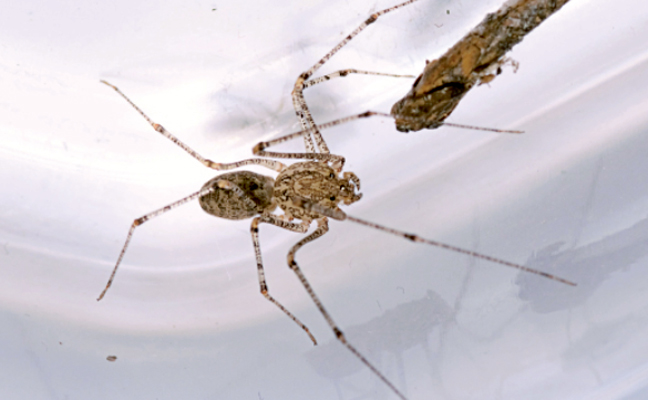
Woodlouse spiders like this one have six eyes, a trait they share with the brown recluse. PHOTO: MARK VANDERWERP, BCE
No spider engenders fear quite like the dreaded brown recluse (Loxosceles reclusa). Some people are so fearful that they see them everywhere. They believe every spider is a potential brown recluse.
Customers are able to get information about spiders online, but too often, the information is wrong. The characteristic most often used by the untrained to identify the brown recluse is the “violin-shaped” mark on its back.
A trained pest management professional (PMP) who sees them regularly should be able to identify a recluse to genus even without a hand lens, but it takes an expert to separate the brown recluse from the Mediterranean recluse (L. rufescens), a closely related species. Those outside the brown recluse’s range may rarely see them, and often rely on a hand lens to count the eyes.
OTHER SIX-EYED SPECIES
The brown recluse has six eyes arranged in three pairs, but there are several other spiders with six eyes. Here are two common examples:
- The woodlouse spider (Dysdera crocata) is a specialist on woodlice — crustaceans that we commonly refer to as pillbugs (roly polies) and sowbugs. These spiders have greatly enlarged jaws and present a fearsome image. They are found where pillbugs and sowbugs are common, and are regularly found in homes. Sticky traps on ground-level slab floors may catch a surprising number of them where there are a lot of pillbugs. Like all our spiders, they won’t bite unless you handle them roughly, but they can deliver a painful nip. Like brown recluse spiders, they commonly are found in sticky traps.
-

The spitting spider also has six eyes, but should not be mistaken for
a brown recluse. PHOTO: MARK SHEPERDIGIAN, BCEOne of our most intriguing spiders is the spitting spider (Scytodes spp.), which also has only six eyes. Spitting spiders are named for their unique method of subduing their prey: They eject a sticky fluid that can glue prey to one spot, so they can safely approach to deliver a fatal bite. Surprisingly, the spitting spider specializes in eating other spiders. They can build a web and wait for other spiders, but they will also approach webs and lure the unsuspecting resident spider to the edge — where deadly aim with their “glue gun” can pin the spider to its own web. Most spitting spider species are quite small, but even the largest shouldn’t be mistaken for a brown recluse.
Leave A Comment